#Wolf eel
Explore tagged Tumblr posts
Text














some ocean creatures for one of my uni projects. i hope i can share something about the final result when it's finally finished, i'm so excited to see how it will turn out :D polygon lasso tool my beloved
#my art#challenger deep (art book)#digital art#illustration#ocean creatures#animals#fish#deep sea creatures#jellyfish#octopus#wolf eel#squid#actually no im not tagging every single animal. sorry
4K notes
·
View notes
Note
give me the UGLIEST FUCKING FISH you've ever seen
Definitely gotta be this thing

You get a Wolf Eel
Anarrhichthys ocellatus
154 notes
·
View notes
Text
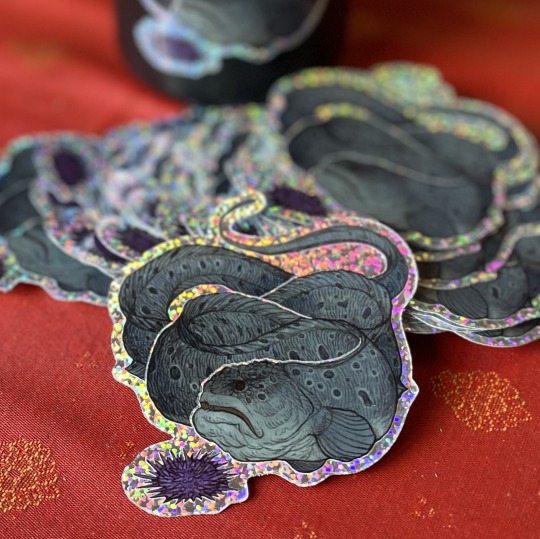
I’m selling stickers! Very limited run to start, as this is something of an experiment, but if glittery wolf eels inspire you, be sure to claim one before they’re gone!
If they DON’T inspire you yet, here are some wolf eel fun facts:
1. Wolf eels typically mate for life, though not until around 7 years of age. However, they may start seeing other eels and spending time in each other’s hides as young as 5.
2. Wolf eels are not true eels (order anguilliformes)! Yet they share many convergent features such as reduced scales, snakelike bodies, and swimming by tipping their body sideways while undulating in a wave motion.
3. Every wolf eel has a unique pattern of spots, that biologists can use to recognize individuals akin to a fingerprint.
4. Baby wolf eels are bright orange! They’re also much more active, spending the first few months of life swimming free in the water column and the next few years searching the sea floor for their forever-home. (Adults tend to be homebodies, unless they’re actively hunting)
5. Wolf eels have powerful jaws packed with molar-like teeth that they use to crack hard and spiny invertebrates. Not even sea urchins are safe!
478 notes
·
View notes
Text
The Natural History Museum of Helsinki has one big wall that shows a sliver of the marine life diversity found in the world’s oceans right in the beginning of the world environments exhibit.








Featuring in the closer photos a preserved sturgeon, a lamprey, two sharks, a sea robin, and a moray eel!
There’s also sharks and whales and other marine life on the ceiling but I forgot to take pictures besides for this wolf eel whoops.

#sturgeon#lamprey#lampreys#shark#sharks#hammerhead shark#sea robin#moray eel#eel#wolf eel#preserved animal#dead animal#tw dead animal#aquatic#natural history museum of helsinki#luomus
169 notes
·
View notes
Text


Wolf eels enjoying sea urchins
#animal#picture#fish#Anarhichadidae#wolf eel#Ray-finned fish#sea urchin#echinoderm#invertebrate#aquatic animal#aquatic#live animal#animals hunting#face
61 notes
·
View notes
Text
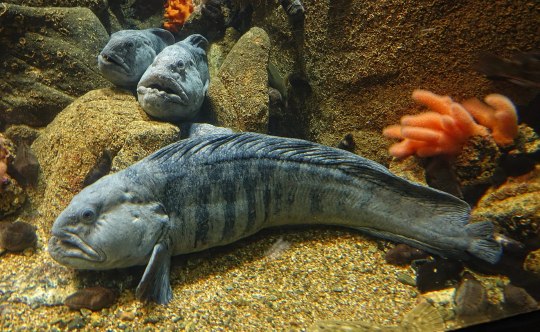
Atlantic Wolffish (Anarhichas lupus), family Anarhichadidae, found in the North Atlantic
photograph by Bjørn Christian Tørrissen
409 notes
·
View notes
Note
Trick and/or treat?


Your treat is: blurry image of a wolf eel I took at work a few hours ago
93 notes
·
View notes
Text
Uncharismatic Fact of the Day
Neither a wolf, nor an eel, it's the infamous wolf eel! Although often referred to as an eel due to its long, slender body, this species actually belongs to the wolf fish family, and is differentiated from true eels by its paired gill slits and pectoral fins. The 'wolf' part of its name comes from the large canine teeth and powerful jaws with which they crush their prey.

(Image: A wolf eel (Anarrhichthys ocellatus) by Tristan Blaine)
If you like what I do, consider buying me a ko-fi!
#wolf eel#Scorpaeniformes#Anarhichadidae#wolf fishes#ray-finned fish#bony fish#fish#uncharismatic facts
121 notes
·
View notes
Text
It’s Wet Beast Wednesday and today’s topic is Anarrhicthys ocellaus, the wolf eel. Despite the name and long-skinny body, they aren’t eels (I’ll get around to true eels eventually, I promise), they’re actually one of the wolf fish, a family of 5 species, the rest of which look less eely. These fish are most famous on the internet for being ugly, which is a bit rude. Sure, they may look a bit like Popeye the Sailor Man, but that’s no reason to be insulting. I think they’re kind of cute, in a pug sort of way.
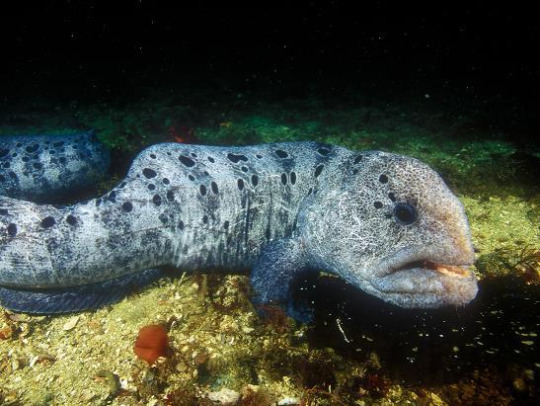
(Image: a wolf eel)
Wolf eels live in cold pacific waters in the Sea of Japan up into the Sea of Okhotsk, across the Aleutian islands, and down to southern California. Their long, slender bodies can grow up to 2.4 meters (about 8 feet) long ang weigh up to 18.4 kg (41 pounds), making them both longer and heavier than some children. Like moray eels, they prefer living in caves and crevices, often only sticking their heads out to look for food. Many will find a suitable cave as a juvenile and never leave unless forced out by a larger wolf eel or another cave-dweller like the giant pacific octopus. Wolf eels have a layer of mucus covering their bodies that helps protect from disease. Their scales are small and imbedded in their skin, giving their skin a leathery appearance. Each individual has a unique pattern of spots on their head, which can be used to identify them.

(Image: a wolf eel)
Wolf eels have large and powerful jaws and well as notable teeth. They are heterodonts, meaning they have teeth of different shapes that serve different functions. This is actually somewhat uncommon amongst animals. Amongst extant vertebrates, only mammals, some fish, and snakes have this feature. Wolf eels have molars and canines. In fact, the prominent canines of the wolf fish family is the origin of their name. Wolf eels use their hard molars and powerful jaws to crush and eat hard food. Their preferred diet includes sea urchins, sand dollars, crustaceans, and bivalves. They rarely eat soft food and aquarium specimens that have been fed soft food extensively can show poor dental health.
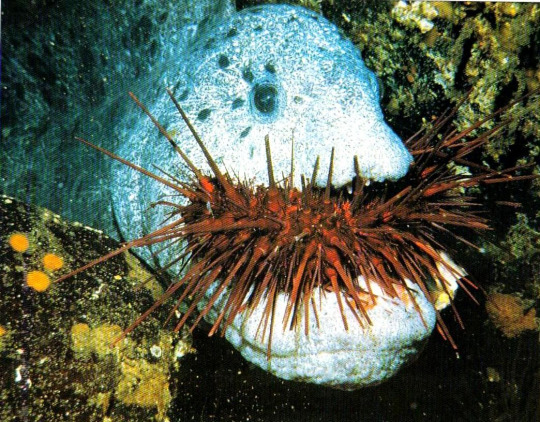
(image: a wolf eel monching on eating an urchin)
If you need more reasons to not insult them, wolf eels are romantics and model parents. They are monogamous and mated pairs will live and mate together for life. These pairs have a unique form of mating behavior. The male will nuzzle the female with his head and coil around her while she lays her eggs (up to 10,000 at a time), which he will then fertilize. Afterwards, the female will coil around the eggs to shape them into a ball She will occasionally rotate and massage the egg ball to make sure all the eggs are getting exposed to oxygenated water. When both are in the cave, the female will coil around the eggs to protect them while the male coils around her for more protection. Both parents share egg protecting duties, with only one leaving to go eat at a time. Once the eggs hatch, the larvae will leave the nest and move to the open ocean to grow. Juveniles live in the open ocean and have a different diet than adults. They are more active predators who use their canines to attack and eat small fish and fish larvae. After a few years, they will make their way back to shallower waters to take up their adult lifestyles. They become sexually mature at around 7 years old, though some will par up with their future mate as early as age 4. In addition, juveniles are bright orange with purple spots. They become darker as they age, eventually becoming fully grey.

(image: a pair of wolf eels protecting their eggs, the yellowish ball on the middle)

(image: a juvenila wolf eel)
Wolf eels are rather curious and even playful animals. In places with lots of human activity, they can become used to divers. In fact, they can even become friendly with divers, sometimes coming out to play with them and being happy to receive chin scratches. In many places, divers can hand-feed the wolf eels. This is controversial as it can disincentivize natural hunting behavior and ignorant divers may feed the eels the food that is bad for them. Wolf eels are very rarely aggressive, but they can deliver very painful bites if provoked.

(image: a wolf eel and a diver)
Wolf eels are classified as “least concern” by the IUCN, meaning they are in no danger of extinction. Still, threats to them include bycatch and pollution. They are rarely targeted for fishing today, but in the past, they were targeted by a few Native American tribes. In these, they were considered to be sacred “doctorfish” and were only eaten by healers, in the belief it would enhance their healing abilities.
UPDATE: after doing some digging regarding the usage of the fish by Native American tribes I found that everyone who makes this claim seems to reference the book "Probably More Than You Want to Know About the Fishes of the Pacific Coast" by Milton S. Love, which itself cites a book from either 1868 or 1870 titled "The Indians of Cape Flattery, at the entrance to the Strait of Fuca, Washington Territory" by James Swan. The book specifically discusses the Makah people. I'm a bit skeptical about the source so take those claims with a grain of salt.

(image: a wolf eel sticking out of a rock)
531 notes
·
View notes
Text
New creature! His name is Sporticus.
#aquarium#blorbo#cute animals#fish#marine animals#marine biology#funny#meme#cute#fishposting#cute fish#fishblr#fishtank#eel#wolf eel#sporticus#all hail blorbo#blorboverse
40 notes
·
View notes
Text
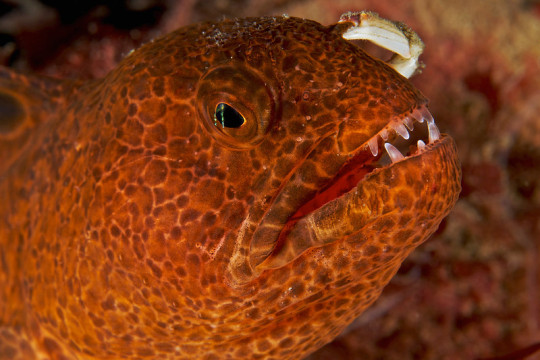
A juvenile wolf-eel (Anarrhichthys ocellatus) in Puget Sound, Washington, USA
by Scott Okumura
#wolf eel#eels#bony fish#fish#anarrhichthys ocellatus#anarrhichthys#Anarhichadidae#Scorpaeniformes#actinopterygii#chordata#wildlife: washington#wildlife: usa#wildlife: north america
112 notes
·
View notes
Text
ok I know moray eel Neil is kinda the thing I’m known for so I’m back on my Neel bullshit. But slightly different this time because what if Neil was a wolf eel instead? Wolf eels aren’t true eels (they have fins so they’re actually just fish. They aren’t wolves either). Neil has a shit ton of fake identities to try and blend in a survive. Wolf eels don’t have a swim bladder (that’s what fish use to stay floating so they don’t sink and die (fun fact manatees don’t have one either and instead keep themselves up by farting)) without a swim bladder wolf eels either have to be constantly moving or in a safe den. Neil spent his entire life constantly moving around on the run or he’d die. Wolf eels mate for life and will stay in the same den with their partners for their entire life (unless a bigger wolf eel or giant pacific octopus kicks them out). Once Neil is with the foxes and Andrew he stops running and can actually rest. Also he’s Demi and stays with Andrew and doesn’t have to run anymore to stay alive, they can just rest in their den. Oh also juvenile wolf eels are bright orange. And they like chin scratches. @c-lion this isn’t the project I was talking about but I’m tagging you anyway so hii
here’s some pictures of them under the cut

This is an adult wolf eel. I think it’s male based on the coloring but the website the picture is from doesn’t say so I’m not entirely sure. Males are lighter in color and bigger than females.

This is a juvenile wolf eel. As they grow up the coloring changes to grey. The picture is from here
#aftg#all for the game#neil josten#andreil#wolf eel#I can relate anything to aftg ok#I love wolf eels so much they’re so cool
9 notes
·
View notes
Text
VERY IMPORTANT ANNOUNCEMENT
look at this gif of a Wolf Eel getting a little urchin snack!!!

#I love him#silly little eel#wolf eel#aquatic animals#gif#its not mine I stole it off of google#bug talks
6 notes
·
View notes
Text

According to the note under the pic, this wolf eel is a juvenile. Don't know if that's true or not.
from https://www.boredpanda.com/terrifying-job-photos/
6 notes
·
View notes
Note
what’s your opinion on wolf eels i personally love them :3
I love wolf eels!!!! Super cool fish!!!! Very very important to the ecosystem because they control sea urchin and crustacean populations and they're so interesting, they have antifreeze blood!!!! I love love wolf eels and they're underrated to be honest. They're not really eels despite the name but they should be up there I think. Mostly I see them talked about in relation to their appearance
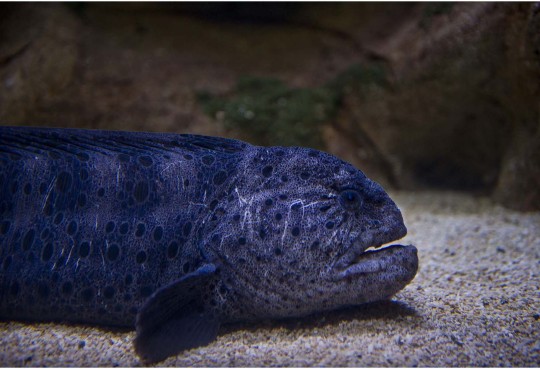
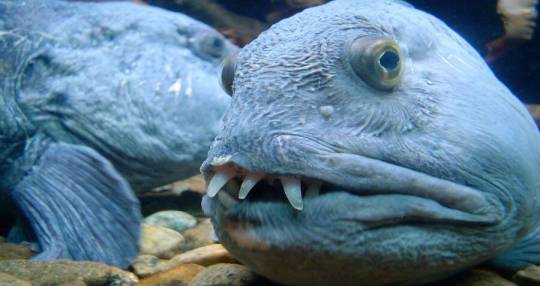
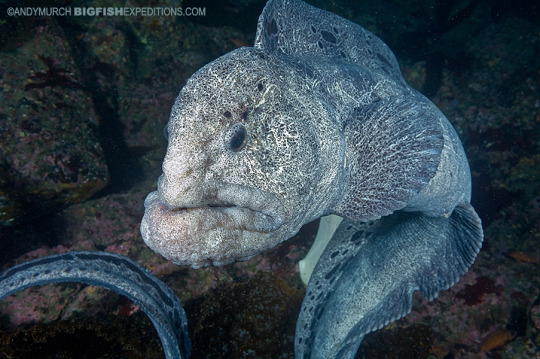
How could you say you dislike cutie patooties like this?
#the middle one wouldve made rounds during the “derp” “kawaii potato” “llamocado” era of the internet#asks#x-xvampyrexgutzx-x#wolf eel
129 notes
·
View notes
Text


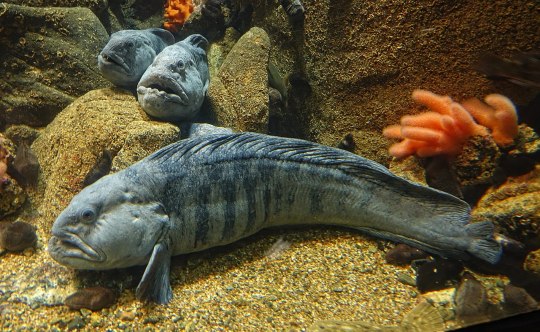



The Atlantic wolffish (Anarhichas lupus), also known as the seawolf, Atlantic catfish, ocean catfish, devil fish, wolf eel, woof or sea cat, is a marine fish of the wolffish family Anarhichadidae, which is native throughout the North Atlantic Ocean with the densest populations being occurring at Georges Bank, the Gulf of Maine, the Irish Sea, Denmark Strait, and White Sea. As a benthic dwelling cold water species, the Atlantic wolffish are primarily stationary fish which primarily inhabit sea floor nooks and caves around 66 to 1,640ft (20 to 500m) in depth. They prefer temperatures of −1 to 11 °C (30–52 °F). To survive such cold temperatures there blood contains a natural antifreeze. Atlantic wolfish are uniquely adapted to use their strong jaws to crush and crack open the shells of molluscs, crustaceans, and echinoderms, and are a vital predator of sea urchins, green crabs, and starfish. Reaching up to 5ft (1.5m) in length and 40lbs (18kg) in weight, The Atlantic wolffish has retained the bodily form and general external characteristics of small blennies albeit just on a much larger scale. Its body is long, subcylindrical in front, compressed in the caudal portion, smooth and slippery, the rudimentary scales being embedded and almost hidden in the skin. Atlantic wolffish vary in color, usually seen as purplish-brown, a dull olive green, or blueish gray. An even dorsal fin extends the whole length of the back, and a similar fin from the vent to the caudal fin, as in blennies. The pectorals are large and rounded and the pelvic fins are entirely absent. Its obtuse, eel-like body type makes the fish swim slowly, undulating from side to side, like an eel.The Atlantic wolffish's distinguishing feature, from which it gets its common name, is its extensive teeth structure with Both the lower and upper jaws are armed with four to six fang-like, strong, conical teeth. Unlike most fish, Altantic wolffish perform internal fertilization and form close mated pairs in which both parents care for and guard there nest of eggs which they build out of sea weed and stones. After hatching the young will stay with there parents for up to four months, until they are strong enough to gain independence. Under ideal conditions an atlantic wolffish may reach sexual maturity at around 6 years of age and may live upwards of 20.
#pleistocene#pleistocene pride#pliestocene pride#pliestocene#cenozoic#atlantic#atlantic wolffish#wolf#wolffish#fish#sea wolf#wolf eel#sea cat#sea catfish#atlantic catfish#woof
19 notes
·
View notes